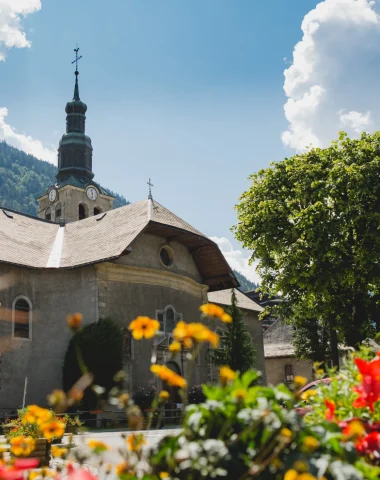Morzine, a village with character in Haute-Savoie.
Come to Morzine once and you’re sure to want to come back! It’s true that when you see just how charming and authentic the narrow streets of the village are, you’re pretty much guaranteed to experience love at first sight.
Set in the midst of forests and mountain peaks, the village has managed to keep its authentic Savoyard style with beautiful chalets dotted throughout the centre, and the traditions and typical way of life have also been preserved over time. The village has really managed to safeguard its traditional charm thanks to the many shops that have sought to achieve the perfect compromise between nature and urban development, and the chalets and houses that still boast the traditional architectural styles. Everywhere you look, you’ll also see the unique local expertise, in the architecture, heritage, local food and drink, materials, culture, etc. For years now, these traditions have been passed down through the generations, and that is what visitors love to see when they come to Morzine.
Before the birth of winter sports, Morzine made a living from the slate industry





Before the birth of winter sports, Morzine made a living from the slate industry
In 1900, slate mining was one of Morzine’s main activities thanks to the schist quarries in the surrounding area. Between November and May, some two hundred slate miners worked at these quarries.<br>The slate extracted can still be seen today on the roofs of Morzine. There are still three sites operating here and they now adapt to new trends such as decorative items that are popular with both the locals and tourists.

Tourism has always been a deeply rooted practice in and around Morzine
Morzine was one of the first resorts to welcome tourists in the early 20th century, and was mainly a summer destination back then. At that time, the arrival of tourists was a breath of fresh air for the locals who made a modest living out of farming and the already declining slate mining industry. In the 1920s, the current Route de la Plagne, the main road running through the village, was used as a ski slope. Back then, skis were just simple planks that were raised at the end and attached using straps. Ski lifts had not yet been invented.
The tourism industry experienced exponential growth in the 1930s. By 1936, Morzine already boasted 15 hotels, 5 guesthouses, 60 rental chalets and a mountain chalet. Altogether, this represented 850 tourist beds, with a capacity to welcome 2,500 people in summer and 1,800 in winter. Morzine was the most well-equipped resort in the Chablais region for tourism.
Construction of Le Pleney cable car (capacity: 25) had begun two years prior, in 1934. The cable car began operating on 15 December the same year, and was officially inaugurated on 12 January 1935. This marked the beginning of winter sports holidays. Other infrastructure and facilities followed suit over the following decades. The Super-Morzine gondola lift was built in 1952. It was put into operation in January 1953 but then halted in 1964 due to a fire. Work to build Nyon cable car began and was completed in 1960 (capacity: 35) and then Prodains cable car that linked Morzine and Avoriaz, in 1961 (capacity: 80). Also in the 1960s, one of the greatest innovations in the area of Morzine was of course the official unveiling of the resort of Avoriaz on 8 January 1967.
Since then, the range of accommodation has developed so much, and the resort has become a very attractive destination for French and foreign tourists. Morzine now boasts some 40 hotels in the village, and some of them are run by families that have lived in Morzine for generations.
The village is fiercely proud of its status as a ‘resort offering great hospitality’.
Morzine’s La Battante is bridging the gap between the past and presenT
The village of Morzine is also proud of its past and its traditions. The ‘La Battante Morzinoise’ association is a perfect example of this. It was created in 2012 as part of the plans to rebuild a sash sawmill in the village.
In the 19th century, this sash sawmill produced beams and planks using the driving force of the water. The water wheel used for this project at the entrance to Dérêches Park dates back to 1914. For a long time, the locals of Morzine and a great number of volunteers worked hard and devoted their time and expertise to ensuring the success of this project.
This building surrounded by greenery acts as a bridge between the past and present and is sure to be a hit with visitors and those exploring the area.
La Battante is open to visitors every day. There are some educational signs there featuring information about the project and the fantastic work done by the association and its volunteers. If you’d like to find out more about Morzine, its history and heritage, we recommend going on the Morzine heritage tour with a Savoie Mont Blanc heritage guide. Thanks to the guide, you’ll be able to discover the old town and see how Morzine has changed over the centuries (housing, way of life, traditions, history of Savoie, church, etc.). You can pick up a free heritage map from the Tourist Office.

Thematics















